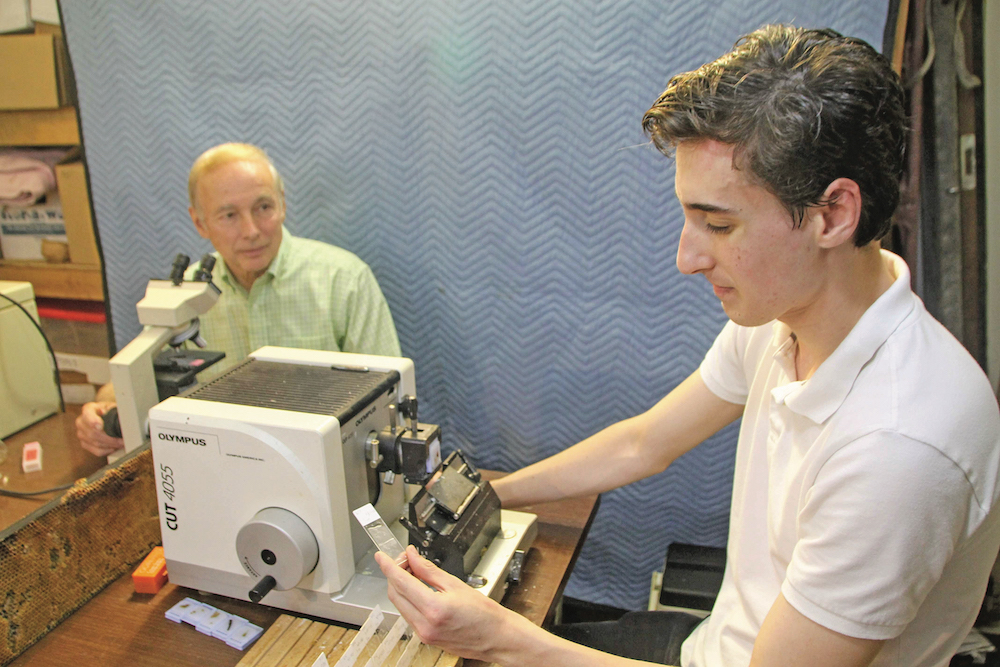Greenport junior’s bee findings submitted to renowned scientific journal

Joe McInnis’ eighth-grade science fair project has come a long way.
After showing promise as a science student, Joe was urged to look for a challenging project to work on by Bob Jester of Greenport, a retired Riverhead High School science teacher. That friendship led to the then 14-year-old’s connection with retired Plum Island veterinary pathologist Doug Gregg.
The two started research on a virus that they thought might be killing honeybees back in 2015. Now, they’ve submitted their findings to be reviewed by Nature, one of the world’s most recognized scientific journals.
Joe, now a 17-year-old junior at Greenport High School, and Mr. Gregg suspected iridovirus, a virus that suppresses invertebrates’ immune system and has what Joe calls an “AIDS-like effect” on them, could be infecting honeybees and keeping them from returning to their colonies, as well as making them more susceptible to disease.
“We were talking to experts that had mapped out this virus’s code, and they didn’t think it was possible for it to infect honey bees. But we recently proved that that was possible,” Joe said.
While working at Plum Island, Mr. Gregg had worked with African swine flu, the only iridovirus found in mammals. Just before Joe reached out to Mr. Gregg about mentoring him, Mr. Gregg said an article published by the U.S. Army had caught his attention, because it showed traces of iridovirus in dying bees. They then went to work using Mr. Gregg’s past research experience to prove honeybees’ vulnerability.
The idea has been overlooked by the scientific community, Joe and Mr. Gregg said, because it is not thought that bees are susceptible to the virus.
“This will be huge,” Mr. Gregg said. “I’m pretty confident this is the underlying cause of colony collapse disease in honey bees.”
Pesticides have long been pinned as the cause of colony collapse disorder, which first cropped up around 2006.
“We’re hoping that it can be reconsidered now, with this proof,” Joe said. “Look — this virus can exist in bees, and it could be significantly contributing to the collapse of bees.”
The two have worked together for the past four years out of the basement of Mr. Gregg’s piano repair studio in Greenport, with donated equipment they have collected and donated honeybee brood combs from Salt Air Farm in Cutchogue. They have been researching the idea that the infection is transmitted to the bees through pests that live within the hive.
The pair believe that wax moth larvae, which are commonly found in honeybee colonies and are particularly susceptible to iridovirus, are infecting deer tick-like mites called varroa mites, which also co-inhabit the hives. The mites, in turn, spread the virus to the honeybees.
“[Mr. Gregg] and I just think the transmission really makes sense,” Joe said. “The first step in proving that was finding out if the virus can replicate itself in bees in the first place. That’s something that people had just given up on, and that was really the idea behind our project.”
While honey bees are not native to the United States — European settlers first brought them here — and can’t replace the pollination services provided by native bees such as bumblebees, they enable the production of at least 90 commercially grown crops in North America, according to 2014 release from the White House.
“All of the pollinator species are having a hard time right now,” said Laura Klahre, who owns Blossom Meadow Farm in Southold and raises native bees.
Going forward, Joe said he would like to hone in on the specifics of how the virus enters the bees.
“We’d like to find a transmission pathway to try and find out how the virus gets into the bees,” he said. “From there we could figure out whether the virus is actually harming the bees, though we suspect it is.”
Deborah Klughers of Southold, an Eastern Apiculture Society master beekeeper, said this research is promising.
“The varroa mite is the single largest global threat to the honey bees,” she said.
“I think it’s great no matter what this research finds — it brings attention to this issue,” she said.
In 2016, Joe became the youngest person to receive a scholarship from the New York State Histotechnological Society, and last year he received the Long Island Science Congress Senior Division’s highest honors. He has also held talks about his research at Southold Middle School, Peconic Landing and at the East End Seaport Museum.
Joe said he is eagerly awaiting a response after submitting their findings to scientific journal Nature and hopes that if it is published others can help contribute to solutions to the colony collapse crisis.
“We hope it will encourage people to look at the problem with closer scrutiny — rather than focus on the politics that it’s definitely pesticides or climate change — sort of reconsider the problem,” he said. “We really hope it will have that positive effect.”
Photo caption: Joe McInnis works on his bee research project with his mentor, retired Plum Island veterinary pathologist Doug Gregg. (Ericka Peters photo)









